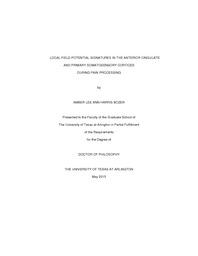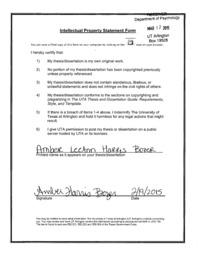
ATTENTION: The works hosted here are being migrated to a new repository that will consolidate resources, improve discoverability, and better show UTA's research impact on the global community. We will update authors as the migration progresses. Please see MavMatrix for more information.
Show simple item record
| dc.contributor.author | Harris Bozer, Amber Lee Ann | en_US |
| dc.date.accessioned | 2015-07-31T22:09:57Z | |
| dc.date.available | 2015-07-31T22:09:57Z | |
| dc.date.submitted | January 2015 | en_US |
| dc.identifier.other | DISS-13013 | en_US |
| dc.identifier.uri | http://hdl.handle.net/10106/24998 | |
| dc.description.abstract | Pain is the primary motive to seek physician care and animal research is informative for investigating the brain activity that underlies pain. Extensively studied brain areas involved in pain processing include the anterior cingulate cortex (ACC) and primary somatosensory cortex (S1) which contribute to the emotional and sensory dimensions of pain processing, respectively. Rodent studies have implicated these areas using a variety of methods including: examining behavioral effects of lesions, post-mortem tissue recording or biomarking, and recording or stimulation of intact target areas. However, information about the broad-range, low-frequency neural activity known as local field potential (LFP) in those areas has yet to be extensively investigated in real time. A series of experiments were designed to elucidate the local field potential activity in the ACC and S1 areas during carrageenan inflammation and by peripheral nerve stimulation using the novel cuff stimulating electrode (CSE) model implanted at the L5 nerve site. Results indicated that the S1 responded similarly with no significant changes to a variety of mechanical and electrical stimulations whereas the ACC responded in a stimulus intensity-dependent fashion to resting inflammation and suprathreshold mechanical stimulation. A trend towards a graded, intensity-dependent relationship between electrical stimulation and ACC LFP emerged, albeit was not significant. Further examination of the CSE model in a separate experiment explored the possibilities of using the model as a spontaneous pain model. Peripheral nerve stimulation by CSE yielded spontaneous pain behaviors at the high (100 Hz, .5v) stimulation parameter. Aversiveness of the stimulation measured with an avoidance paradigm did not yield significant avoidance of high vs. low stimulation over time, yet avoidance scores were consistent with previously published data for other pain conditions. Taken together, these findings elucidate the low-frequency brain activity in the ACC and S1 and demonstrate potential for the CSE model for use in investigating spontaneous pain. | en_US |
| dc.description.sponsorship | Peng, Yuan Bo | en_US |
| dc.language.iso | en | en_US |
| dc.publisher | Psychology | en_US |
| dc.title | Local Field Potential Signatures In The Anterior Cingulate And Primary Somatosensory Cortices During Pain Processing | en_US |
| dc.type | Ph.D. | en_US |
| dc.contributor.committeeChair | Peng, Yuan Bo | en_US |
| dc.degree.department | Psychology | en_US |
| dc.degree.discipline | Psychology | en_US |
| dc.degree.grantor | University of Texas at Arlington | en_US |
| dc.degree.level | doctoral | en_US |
| dc.degree.name | Ph.D. | en_US |
Files in this item
- Name:
- HarrisBozer_uta_2502D_13013.pdf
- Size:
- 897.8Kb
- Format:
- PDF
- Name:
- Harris Bozer, Amber Lee Ann.pdf
- Size:
- 41.83Kb
- Format:
- PDF
- Description:
- Copyright License Agreement
This item appears in the following Collection(s)
Show simple item record



